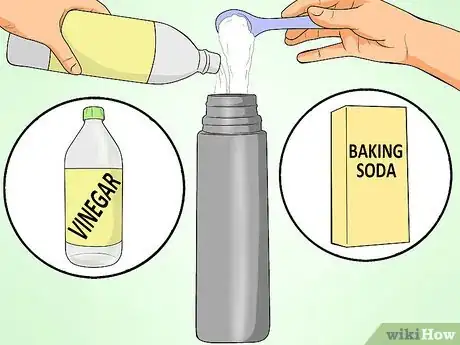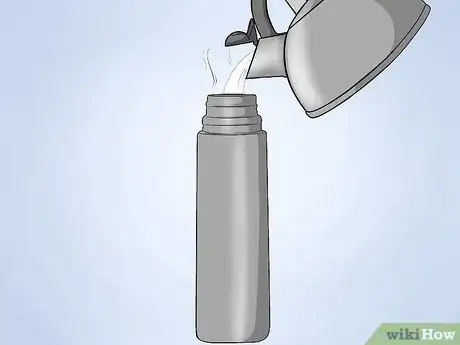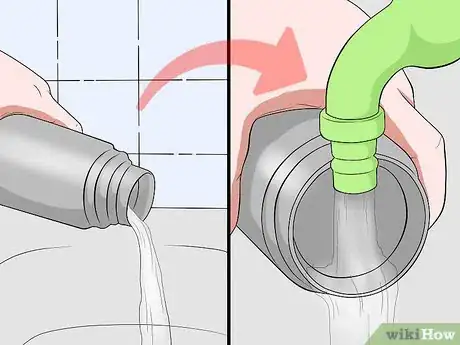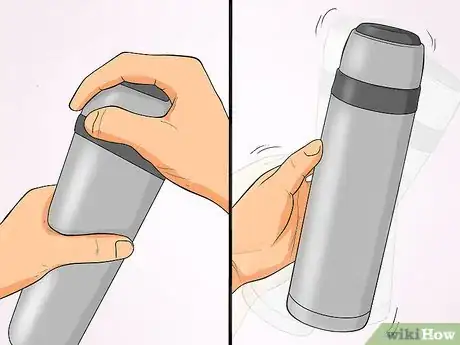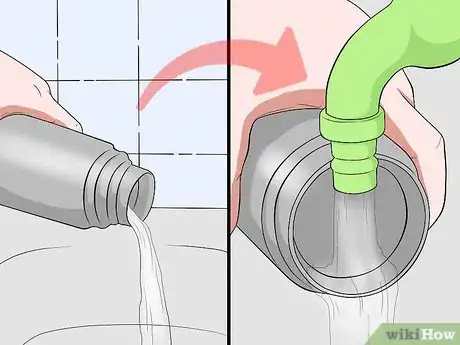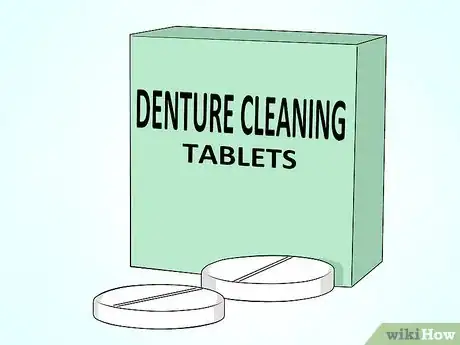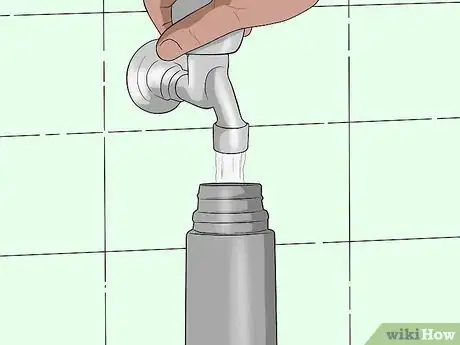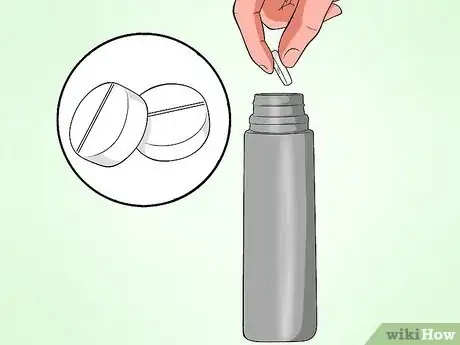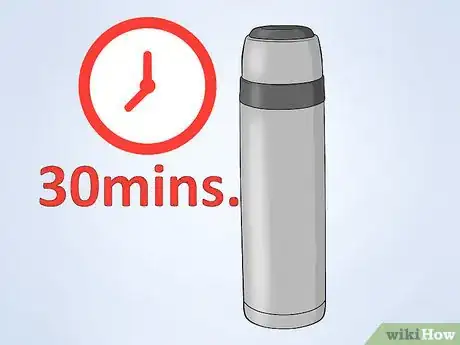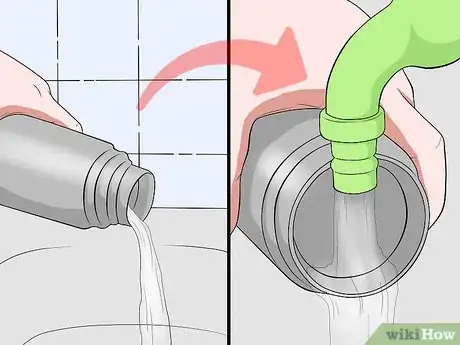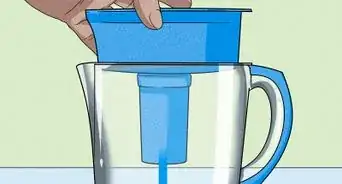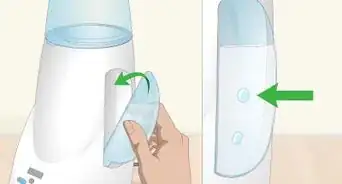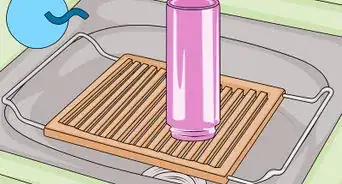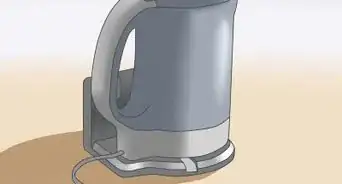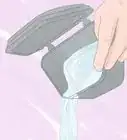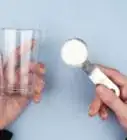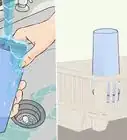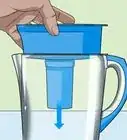This article was co-authored by wikiHow Staff. Our trained team of editors and researchers validate articles for accuracy and comprehensiveness. wikiHow's Content Management Team carefully monitors the work from our editorial staff to ensure that each article is backed by trusted research and meets our high quality standards.
There are 7 references cited in this article, which can be found at the bottom of the page.
wikiHow marks an article as reader-approved once it receives enough positive feedback. In this case, 100% of readers who voted found the article helpful, earning it our reader-approved status.
This article has been viewed 255,084 times.
Learn more...
Insulated flasks are all the rage these days, and for good reason. They’re affordable, easy to carry and keep your favorite beverages just the right temperature for hours and hours. Because of their construction, however, they can be difficult to clean after they’ve been used to hold coffee, tea and other liquids that can cause discoloration of the metal inside. The good news is that there are several quick and easy ways to rid your flask of unsightly stains, and most only require basic materials that you can find around the house.
Steps
Using Baking Soda and Vinegar
-
1Put some baking soda and vinegar into the bottom of your flask. Pour about half a cup (120ml) of distilled white vinegar into your stained flask. Then, shake in approximately one tablespoon (15ml) of baking soda for every cup the flask holds. The vinegar and baking soda mixture will froth up, so be sure to put the flask in the sink when you combine them.[1]
- Baking soda and vinegar are excellent at killing germs and wearing down stains when acting together.[2]
- It’s important to use distilled white vinegar, as it's more acidic and will result in a better cleaning. It’s also less likely to leave a lingering odor or taste in your flask, which other types of vinegar may do.
-
2Fill the flask with hot water. After the fizzing baking soda mixture has died down, fill the flask the rest of the way up with hot water. This will help loosen the dried stains from the inner surface of the flask, as well as distribute the vinegar and baking soda throughout. Leave the cap off the flask to keep the pressure from building up too much.[3]
- Baking soda and vinegar are notoriously reactive. Putting the cap on the flask with both substances inside could result in a messy leak or even damage.
Advertisement -
3Let the flask sit for a few minutes. Leave the flask to soak for 8-10 minutes. The baking soda solution will begin working on the worst of the discoloration while the heat of the water softens and collects the stain-causing residue. It’s as easy as that![4]
- For especially thick buildup or heavy discoloration, give the vinegar and baking soda longer to set up.
-
4Scrub the inside of the flask with a bottle brush. Purchase a bottle brush in the baby aisle of your local supermarket or department store. These brushes were designed to clean out the types of bottles used to feed infants, which tend to be tall and narrow, so they’ll work perfectly for scrubbing out your flask. Use the bottle brush to scour away any stubborn spots that the baking soda mixture hasn’t already removed.
- A basic bottle brush only costs about $5, but it’s a very useful tool to have on hand for difficult cleaning jobs.
- Be sure to run your bottle brush through the dishwasher after using it to clean a stained flask.
-
5Pour out the mixture and rinse. Dump out the mixture so that the flask is completely empty. Rinse it repeatedly with hot water until no trace of vinegar or baking soda remains. Don’t forget to rinse around the opening of the flask. Your flask should now be clean and ready for use.[5]
- Pat the body, mouth and cap of the flask dry with a clean towel, or let it sit and air dry.
- Give the opening of the flask a sniff. If you can still smell vinegar, rinse it a few more times, or fill it with hot water and let it soak, until it’s odorless.
Using Ice and Salt
-
1Fill your flask with ice. Empty out your flask if there is any liquid in it. Load the flask about a quarter of the way full with ice. It’s best if the ice is crushed or in smaller, irregularly shaped pieces, though normal cubes will also work. The exact amount of ice you use will depend on the size of your flask.[6]
- The type of bagged ice you can buy at the grocery store is perfect for this task.
- If you only have access to large, smooth or rounded ice cubes, you can break them up into a more effective size yourself by placing them in a plastic bag and crushing them or throwing them in a food processor.
-
2Add a few spoonfuls of salt. Sprinkle 2-3 heaping spoonfuls of salt over the ice. For the purpose of cleaning, salt of a larger grain, such as coarse-ground kosher salt or sea salt, will get the most done. Add the salt to the flask quickly so that the ice you put inside doesn’t have a chance to melt.[7]
- Use an extra half tablespoon (about 7ml) of salt if its a finer grain.
- Ice that melts in the flask may dissolve the salt, making it less useful for cleaning.
-
3Close the lid and shake. Place the lid on the flask and make sure it’s secure. Shake the flask vigorously. As the hard ice and jagged salt granules move around inside the flask, they’ll scrape away whatever stains and grime have accumulate on the insulated metal. Shake for as long as you want, until you feel confident that the ice and salt have done their job.[8]
- The salt and ice combination will essentially act as an “exfoliant” for the walls of the flask.
- Don’t worry about damaging the metal that your flask is made of. They’re designed to withstand extreme temperatures, mild impacts from being dropped and general wear and tear.
-
4Rinse out the flask. Take the lid off the flask and pour out the ice-salt mixture. Run some warm water into the flask and swirl it around to remove any lingering remnants. Rinse the mouth of the flask as well, and leave the lid off as it dries.[9]
- Using ice and salt to wear down stains is a safe, natural solution. Both ingredients are non-toxic and don’t contain chemicals that may be harmful if ingested.
Using Denture Cleaning Tablets
-
1Buy a package of denture cleaning tablets. Run down to your local pharmacy and pick up a pack of dissolving denture cleaning tablets. Most denture tablets contain sodium bicarbonate (baking soda) as an active ingredient, which fizzes when the tablets are added to water. They are designed to eliminate stains from artificial teeth as they soak, which means they’re perfectly safe to use for objects that you’ll be putting in or around your mouth.[10]
- A pack of denture tablets will only run you a few dollars, providing many uses in cleaning your well-used flask.
- The dissolving action of denture tablets also has an antibacterial effect, sterilizing the flask as they clean.[11]
-
2Fill your flask with water. Fill your empty flask to about the halfway point with warm or hot water. The higher the temperature of the water, the faster it will begin to loosen the hold of troublesome stains. Allow the flask to soak for a few minutes before moving on to the next step.[12]
- Swish the water around inside the flask to make sure it’s completely wet throughout. This will help the sodium bicarbonate react on all parts of the flask’s inner surface.
-
3Add one or two denture cleaning tablets. Drop a couple of denture tablets into your water-filled flask. The chemical reaction will cause the water to bubble and foam up, so it’s best to do this in the sink, outside or somewhere you don’t have to worry about making a mess. Don’t cap the flask—this will cause pressure to build up inside.[13]
- A good general guideline is to use one tablet for every two cups of the flask’s volume.
-
4Let the flask sit for awhile. Walk away from the flask while the tablets do their thing. As they dissolve, the effervescent action will also disintegrate the buildup on the walls of the flask. Allow the flask to sit for up to half an hour, until the effect of the tablets has begun to diminish.[14]
- Denture cleaning tablets are one of the safest and most effective ways to clean a dirty flask or thermos. All you have to do is wait.
- Once the reaction has died down, you can go over the inside of the flask with a bottle brush for a more thorough clean.
-
5Rinse repeatedly. Pour out the water that the denture tablets dissolved in. Run fresh water in and out of the flask a few times to clear away whatever traces are left behind. While the flask is drying, keep it right-side up with the cap off. Afterwards, it will look as good as new![15]
- Putting the cap on your flask while it’s still wet will encourage bacteria to set up shop inside.
Community Q&A
-
QuestionWhat are denture tablets, exactly?
 Community AnswerDenture cleaning tablets are small, disc-shaped concentrations of effervescent substances typically used to soak stained and dirty dentures. They usually contain sodium bicarbonate, or baking soda, in addition to a few other ingredients that provide antimicrobial benefits. When added to water, they foam and fizz. This chemical process scrubs away stains on a microscopic level.
Community AnswerDenture cleaning tablets are small, disc-shaped concentrations of effervescent substances typically used to soak stained and dirty dentures. They usually contain sodium bicarbonate, or baking soda, in addition to a few other ingredients that provide antimicrobial benefits. When added to water, they foam and fizz. This chemical process scrubs away stains on a microscopic level.
Warnings
- Avoid using sponges and similar implements to clean your flask. These are usually too large to work well, and more often than not will just end up getting trapped inside the narrow body of the flask.⧼thumbs_response⧽
- It’s generally not a good idea to clean your drinking container with harsh and potentially toxic chemical cleaners such as Lysol, bleach or OxiClean. Ingesting even a small amount of these chemicals could make you severely ill.⧼thumbs_response⧽
- Never microwave, freeze or apply direct heat to your insulated flask.⧼thumbs_response⧽
- Vacuum flasks and thermoses should never be put through the dishwasher. The intense heat can strip the flask’s materials of its insulating properties and damage the powder-based finish.⧼thumbs_response⧽
Things You'll Need
- Hot or warm water
- Baking Soda
- Distilled White Vinegar
- Crushed ice
- Coarse grain or kosher salt
- Denture cleaning tablets
References
- ↑ https://www.reference.com/article/clean-metal-thermos-7c50bfb154c06f58
- ↑ http://www.bobvila.com/articles/cleaning-with-baking-soda-and-vinegar/#.WCU9BvkrLIU
- ↑ https://www.reference.com/article/clean-metal-thermos-7c50bfb154c06f58
- ↑ https://www.reference.com/article/clean-metal-thermos-7c50bfb154c06f58
- ↑ https://www.reference.com/article/clean-metal-thermos-7c50bfb154c06f58
- ↑ http://www.ebay.com/gds/Top-5-Organic-Methods-for-Cleaning-a-Coffee-Thermos-/10000000178571768/g.html
- ↑ https://theboatgalley.com/cleaning-thermos/
- ↑ http://www.ebay.com/gds/Top-5-Organic-Methods-for-Cleaning-a-Coffee-Thermos-/10000000178571768/g.html
- ↑ https://theboatgalley.com/cleaning-thermos/
- ↑ https://theboatgalley.com/cleaning-denture-tablets/
- ↑ http://www.tigersmiledental.com/ingredients-and-materials-that-make-denture-cleaners/
- ↑ https://theboatgalley.com/cleaning-thermos/
- ↑ https://theboatgalley.com/cleaning-thermos/
- ↑ http://www.onegoodthingbyjillee.com/2015/07/20-things-you-can-clean-with-denture-tablets.html
- ↑ https://theboatgalley.com/cleaning-thermos/
About This Article
To clean a vacuum thermosflask that has stains at the bottom, scrub it with a bottle brush that you’d find in the baby isle of a market. For stubborn stains and germs, put baking soda and vinegar into the bottom of your flask. Once the baking soda mixture has stopped fizzing, fill the thermosflask with hot water to clean entire inner surface. You can also fill the flask 1/4 of the way with ice and a few tablespoons of salt. Then, shake the mixture to allow the ice and salt to scrape away any grime. To learn how to use denture cleaning tablets to clean your thermosflask, keep reading!
